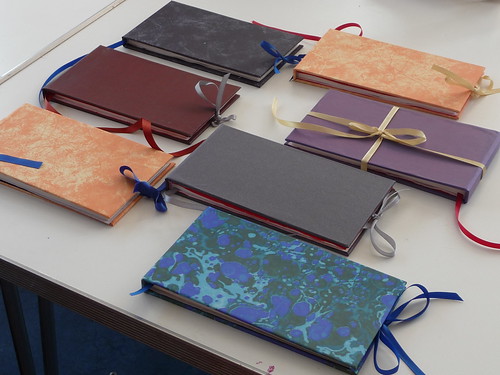A couple of weeks ago I attended a book binding workshop with my friend Claire. The workshop was at Bilston Craft Gallery, and was run by Rachel Marsden. A friend of ours had previously attended one of Rachel’s book binding classes and recommended it so I booked up as soon as I saw the event being advertised. Rachel is a blogger herself, as well as a book & paper artist, curator, researcher, etc!

One of Rachel’s own miniature books
The binding technique we learned during the workshop is pretty straightforward and doesn’t require much equipment or many supplies so would be an easy craft to take up at home. I took some pictures as we were working so you can see the basic steps involved in the process below.
Rachel had set up a workstation with supplies for each of us for when we arrived. Along with some basic tools, she’d prepared 12 pieces of plain card which would form the pages of our notebooks.
The first task for us participants was to fold these pages in half and create (using the awl below but a needle would do) four holes in the spine of each page. One hole 1.5cm from each edge and two holes 5mm from the centre of the spine.
Next up came the sewing! I was very excited to discover I’d get to do some sewing:) The key to this was to loop in and out of the four holes you’d created – so taking your thread in at one end, back out at the second hole, in again at the third and back out at the fourth. It was also essential to loop the thread through the loops from the previous page with each step – to bind the pages together.
Having sewn the pages together we clamped them securely (using two small pieces of wood and elastic bands) while we secured the binding by glueing on a piece of fray (very similar to interfacing) the same size as the spine. A layer of pva glue was placed below and above the fray. We also attached a ribbon (to serve a bookmark) and a piece of headband (the small coloured ribbon-type material you’ll find inside the spine on hardback books) at this point. Both were glued to the spine with pva.
Before releasing our books from the clamps we attached a second piece of fray, this time 2cm wider than the spine on each side, with the four corners trimmed off as below. The point of this fray was to allow the centre pages to be attached to the cover.
Having released our books from the clamps, we attached some lovely coloured endpapers. I used a beautiful (and lucky) paper Rachel had bought in china, which was red with gold speckling. The endpaper was cut slightly larger than the actual pages, folded in half (wrong-side out) and then attached (with a thin line of pva) along the spine edge of the two outermost pages.
By this point we had bound centre pages, but they were in need of a cover. That meant that we got to choose a lovely piece of book cloth. Very exciting!
We cut three pieces of cardboard (front, back & spine) for the cover – slightly larger that the size of the pages, although the spine needed to be the same width. We then cut a piece of book cloth large enough to cover all three pieces of card with a 2cm border around the edges, plus 5mm margins on either side of the spine. The bookcloth is glued to the card pieces to form the cover, and the edges are glued down.
All that was left to do at this stage was to glue in the bound pages. This was done by glueing down the fray attached to the spine of the pages, and then glueing down the outer endpages to cover up the cardboard and secure the pages. As you can see, we were supplied with tea and cake to keep us going while we crafted.
And that was it – we had a finished notebook. I got a few photos of all of our finished books together. I love how we all went for different colours and patterns.
Here’s my own book, with a silver speckled cover and lucky Chinese endpapers. Now I just need to think of something nice enough to put inside it.













